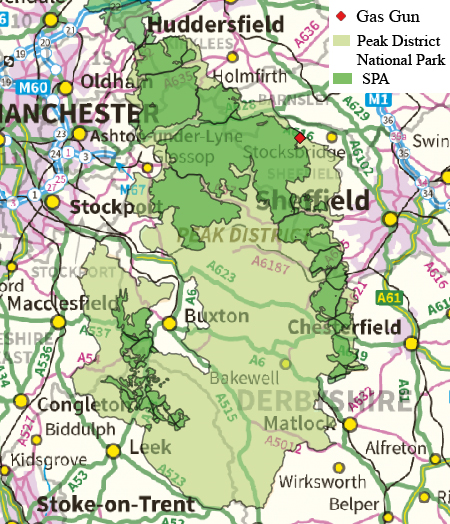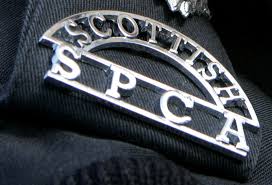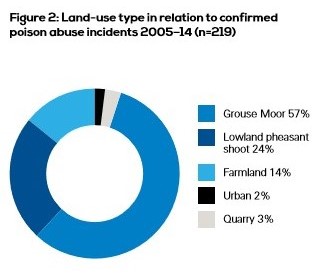As regular blog readers will know, we have an interest in the use of propane gas guns on grouse moors in the English and Scottish uplands.
For those who don’t know, propane gas guns are routinely used for scaring birds (e.g. pigeons, geese) from agricultural crops – they are set up to deliver an intermittent booming noise and the audible bangs can apparently reach volumes in excess of 150 decibels. According to the Purdue University website, 150 decibels is the equivalent noise produced by a jet taking off from 25 metres away and can result in eardrum rupture. That’s quite loud!
The grouse-shooting industry has claimed these are used for scaring ravens, but we argue they are more likely to be used (illegally) to disturb hen harrier breeding attempts. We are interested in the deployment of these bird scarers in relation to (a) their proximity to Schedule 1 (and in Scotland, Schedule 1A bird species) and thus any potential disturbance to these specially protected species and (b) their use in designated Special Protection Areas and thus any potential disturbance caused.
We, and others, have previously blogged about specific instances of gas gun use on grouse moors (e.g. see here and here) and we’ve been pressing the statutory nature conservation organisations (Natural England & Scottish Natural Heritage) to issue urgent guidelines on their use, so far without much success (see here, here, here, here and here).
Meanwhile, grouse moor managers are still using these gas guns. The following photographs were taken on Sunday 22 May 2016 in the Peak District National Park:




This gas gun is on the Barnside Moor, which is part of the Broomhead Estate, owned by Ben Rimington Wilson, a spokesman (see here) for the grouse-shooting industry’s lobby group the Moorland Association. The grouse moors of the Broomhead Estate are part of a regional Special Area of Conservation (SAC), Site of Special Scientific Interest (SSSI) and Special Protection Area (SPA), designated as a site of importance for short-eared owl, merlin, and golden plover.
Now, what’s interesting about the placement of this particular gas gun is that it lies a few metres outside of the SPA boundary, although the gas gun is pointing towards the SPA:


What’s interesting is whether this gas gun was deliberately placed outside of the SPA boundary, to avoid having to ask Natural England for deployment consent? Although we would argue that even though the gas gun isn’t placed directly within the SPA, it is placed directly adjacent to it and the noise from that gas gun will definitely resonate across the SPA boundary line, potentially disturbing ground-nesting species such as short-eared owl, merlin and golden plover, for which the site was designated. (Hen harrier is not on the site’s designation list, presumably because when the site was designated, there weren’t any hen harriers nesting there, even though this is prime hen harrier habitat!).
But even though the gun isn’t directly placed within the SPA, it does sit (just) within the SSSI boundary:

This leads us to believe that the deployment of this gas gun will require consent from Natural England as it falls under the list of ‘operations likely to damage the special interest of the site’, namely, ‘change in game management and hunting practice’.
Has Natural England given consent for the deployment of this gas gun at this site? If so, how has it justified that deployment? If Natural England hasn’t given consent, is the deployment of this gas gun contrary to section 28 of the Wildlife & Countryside Act?
We don’t know the answers to these questions because we’re still waiting for Natural England to publish its policy on gas gun use, even though this guidance document was promised before the start of the 2016 breeding season!
Natural England needs to pull its finger out, pronto, and publish clear guidelines for use. If you’d like to email Alan Law, Natural England’s Chief Strategy & Reform Officer (he’s the guy who last September told us the guidelines would be available by early 2016) and ask him where that guidance document is, here’s his email address: alan.law@naturalengland.org.uk
You may also remember that a couple of weeks ago, SNH gave their opinion of what we should do if we found a gas gun being deployed on a grouse moor (see here). It was a very confused statement, but part of their advice was that intentional or reckless disturbance of a Schedule 1 species (such as hen harrier or merlin) is an offence and any suspected incidents of this through gas gun use should be reported to the police.
In our view, this would be a big waste of time – we can’t see the police having any interest in investigating gas gun use, and even if they did, they probably wouldn’t know where to start. But, just as a test case, why don’t we report this gas gun to South Yorkshire Police as a suspected wildlife crime (potential reckless or intentional disturbance of a Schedule 1 species) and let’s see what they do with it.
Here is the information you need:
Gas gun grid reference: SK233978, Barnside Moor, Peak District National Park
Date observed in use: 22 May 2016
Please report this to Chief Superintendent David Hartley, South Yorkshire Police’s lead on wildlife crime: david.hartley@southyorks.pnn.police.uk
We’d be very interested in any responses you receive!
And if you’re in email-sending mode, you might also want to sent one to Sarah Fowler, Chief Executive of the Peak District National Park Authority and ask her whether there is a policy for the deployment of bird scaring devices on sensitive moorlands within the National Park. Email: sarah.fowler@peakdistrict.gov.uk




 Last month we blogged about a series of Parliamentary questions relating to wildlife crime that had been lodged by recently elected Scottish Greens MSP Mark Ruskell (see
Last month we blogged about a series of Parliamentary questions relating to wildlife crime that had been lodged by recently elected Scottish Greens MSP Mark Ruskell (see  The reason we’ve mentioned this recent wildlife crime conviction is because this case demonstrates a number of things about the ability and competence of the SSPCA to conduct wildlife crime investigations; things that those opposing extended powers for the SSPCA (Police Scotland, gamekeepers, estate owners etc)
The reason we’ve mentioned this recent wildlife crime conviction is because this case demonstrates a number of things about the ability and competence of the SSPCA to conduct wildlife crime investigations; things that those opposing extended powers for the SSPCA (Police Scotland, gamekeepers, estate owners etc) 


 Thanks to the blog reader who sent this.
Thanks to the blog reader who sent this.
